- Aug 9, 2022
- 35
- Pool Size
- 10000
- Surface
- Fiberglass
- Chlorine
- Salt Water Generator
- SWG Type
- Hayward Aqua Rite (T-15)
Strap in!
2 year old fiberglass pool. Major fading below water level. Pool shell manufacturer Alaglas came out 6 months ago, tech sanded a small piece of step and said its calcium. Advised me to lower calcium to 0
If possible(?) - my hardness was already low (90ppm) so I found this all suspect. I have since read that in a fiberglass pool calcium should be at 200 or so plus (like pool math suggests) to act as a buffer.
I am an a little bit obsessive and avid pool tester, and have used nothing but Taylor kits and TBP pool math recommended levels since day one.
Anyway. The pool tech recommended I buy some jacks magic blue remover - it doesn’t work. Firstly it has to be sprayed on and brushed, I cannot comeptlelu drain my pool for obvious reasons. I did however drop it over half and try the remover but to no avail.
The only joy I’ve had is with sanding a test area - I actually used an 80 grit as that’s the only way I saw any results. Event this only removed a small amount in certain areas. The stain is not scaled or flaky, it does not come off with any physical manipulation except sanding which makes me think it it has been ‘baked’ into the shell. Even then I think the majority of it is oxidation or chlorine bleaching.
I have pool math water balance receipts going back to day 1 shaking my water chemistry as always been within the correct levels. I don’t even use cal hypo shock.
After extensive researching of the subject and trying to find others in a similar boat (there are many) I stumbled across this post on the Australian home one forum:
“Below the water indicates it is a water problem . Prolonged high chlorine or ph. Generally it is pools with a heater on the same pump as chlorinator or people using a pool blanket . Even not turning the chlorine output down in winter can cause high chlorine over winter. All the pools I have seen like this have had heaters connected through the filtration circuit with a salt chlorinator and a solar blanket . This combination will have massive spikes in the chlorine level whilst heating .”
I have a heater with my salt cell in line with it (after the heater, before the return). I have no solar blanket. It’s interesting he says how most of the pools he’s seen with this issue have Themis combination. I personally haven’t seen any spikes (I test every 2 days, sometimes daily) when heating the pool. I don’t understand how this would be a problem but any input and advice would be greatly appreciated. Hoping @Texas Splash sees this as his posts on the matter have been so enlightening.
(On a side note, I noticed some brown staining in the pool at did the vit C test - raised up immediately so I believe it’s iron. Will an absorbic acid treatment be okay if I don’t have a heater bypass?)
2 year old fiberglass pool. Major fading below water level. Pool shell manufacturer Alaglas came out 6 months ago, tech sanded a small piece of step and said its calcium. Advised me to lower calcium to 0
If possible(?) - my hardness was already low (90ppm) so I found this all suspect. I have since read that in a fiberglass pool calcium should be at 200 or so plus (like pool math suggests) to act as a buffer.
I am an a little bit obsessive and avid pool tester, and have used nothing but Taylor kits and TBP pool math recommended levels since day one.
Anyway. The pool tech recommended I buy some jacks magic blue remover - it doesn’t work. Firstly it has to be sprayed on and brushed, I cannot comeptlelu drain my pool for obvious reasons. I did however drop it over half and try the remover but to no avail.
The only joy I’ve had is with sanding a test area - I actually used an 80 grit as that’s the only way I saw any results. Event this only removed a small amount in certain areas. The stain is not scaled or flaky, it does not come off with any physical manipulation except sanding which makes me think it it has been ‘baked’ into the shell. Even then I think the majority of it is oxidation or chlorine bleaching.
I have pool math water balance receipts going back to day 1 shaking my water chemistry as always been within the correct levels. I don’t even use cal hypo shock.
After extensive researching of the subject and trying to find others in a similar boat (there are many) I stumbled across this post on the Australian home one forum:
“Below the water indicates it is a water problem . Prolonged high chlorine or ph. Generally it is pools with a heater on the same pump as chlorinator or people using a pool blanket . Even not turning the chlorine output down in winter can cause high chlorine over winter. All the pools I have seen like this have had heaters connected through the filtration circuit with a salt chlorinator and a solar blanket . This combination will have massive spikes in the chlorine level whilst heating .”
I have a heater with my salt cell in line with it (after the heater, before the return). I have no solar blanket. It’s interesting he says how most of the pools he’s seen with this issue have Themis combination. I personally haven’t seen any spikes (I test every 2 days, sometimes daily) when heating the pool. I don’t understand how this would be a problem but any input and advice would be greatly appreciated. Hoping @Texas Splash sees this as his posts on the matter have been so enlightening.
(On a side note, I noticed some brown staining in the pool at did the vit C test - raised up immediately so I believe it’s iron. Will an absorbic acid treatment be okay if I don’t have a heater bypass?)
Attachments
Last edited:


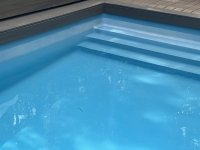
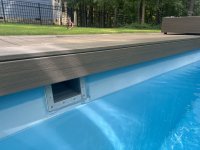
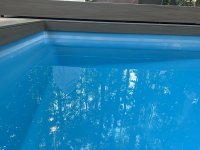
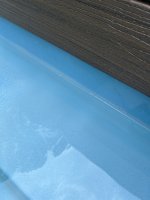
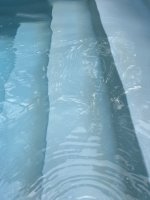
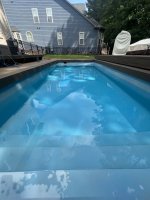
 It's tough, but enjoy your pool for what it is.
It's tough, but enjoy your pool for what it is. 